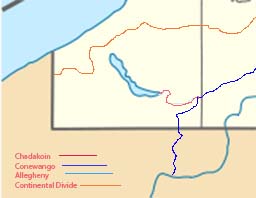Chadakoin River facts for kids
Quick facts for kids Chadakoin |
|
|---|---|

Chadakoin River (red)
|
|
| Country | United States |
| State | New York |
| Physical characteristics | |
| Main source | Chautauqua Lake New York 1,308 ft (399 m) 42°6′42″N 79°16′14″W / 42.11167°N 79.27056°W |
| River mouth | Conewango Creek Frewsburg, New York 1,238 ft (377 m) 42°5′30″N 79°8′11″W / 42.09167°N 79.13639°W |
| Length | 7.8 mi (12.6 km) |
| Basin features | |
| Basin size | 192 sq mi (500 km2) |
| Tributaries |
|
The Chadakoin River is a small river, about 7.8 miles (12.6 km) long. It flows into the Conewango Creek. The Chadakoin River is found entirely within Chautauqua County in Western New York, USA.
This river drains an area of about 192 square miles (497 km²). This covers a large part of Chautauqua County. The Chadakoin River starts at the southern end of Chautauqua Lake. Its path is special because it's near a continental divide. This means its water eventually flows to the Gulf of Mexico, not the nearby Great Lakes.
Contents
Discovering the Chadakoin River's Past
Early Inhabitants and Explorers
Not much is known about the native people who lived near the river before the 1600s. It's thought that the Erie or Wenro tribes might have lived there.
Étienne Brûlé was the first European to explore this area in 1615. He didn't write down which tribes were living there at that time. Later, in the 1650s, the Seneca people, part of the Iroquois League, moved into the region. This happened during a time called the Beaver Wars. The Chadakoin River was an important water route for them. It connected the Great Lakes and Canada with Pennsylvania and places further south.
French Exploration of the River
The first recorded European trip along the Chadakoin River was by Pierre Joseph Céloron de Blainville. In the summer of 1749, he led an expedition to claim the Ohio Valley for France. His group landed on Lake Erie's shore, near what is now Westfield, New York.
They carried their boats and gear overland to Chautauqua Lake. From there, they followed the Chadakoin River and Conewango Creek. They reached the Allegheny River on July 29, 1749.
Jamestown's Connection to the River
The city of Jamestown was founded in the early 1800s. Its location on the Chadakoin River was chosen because the river could power mills. Later, flat-bottomed boats brought goods from downstream to the growing village. Jamestown's mills also used the river to ship lumber downstream.
River traffic slowed down around 1825. By 1840, most of the river's commercial use had stopped.
The River's Changes Over Time
As Jamestown grew, the area around the Chadakoin became a busy industrial center. Factories were built along the river, especially below Warner Dam. Some parts of the river were even covered by buildings. Sadly, the river became polluted and filled with trash.
The first few miles of the river, from Chautauqua Lake to Jamestown, are known as "The Outlet." This part has always been popular for water activities like boating and kayaking. The marshy areas along this stretch are home to many birds and other animals.
Recently, people have been working to improve the riverfront in Jamestown. The goal is to make it easier for the public to enjoy the Chadakoin River. They are creating small parks and walking trails along the river. Cleanup efforts and removing old factory buildings have also made it possible to kayak in parts of the Chadakoin below Warner Dam.
River Traditions
For a while, the river was dyed green for Saint Patrick's Day celebrations in Jamestown. This tradition stopped after 2012 due to money issues. However, the river dyeing started again in 2018.
The Greater Jamestown Riverwalk is a series of parks and walking trails. They run along the Chadakoin River in the city of Jamestown.
Where the Chadakoin River Flows
The Chadakoin River flows entirely within Chautauqua County, New York. It begins by emptying out of Chautauqua Lake at Celoron.
The river then flows generally eastward through the city of Jamestown. It continues to Falconer. Here, a major branch called Cassadaga Creek joins it. This is about 4 miles (6.4 km) east of Jamestown in Levant.
The Chadakoin River then flows south to Frewsburg. There, it empties into the Conewango Creek. The Conewango Creek then flows south into Pennsylvania. It joins the Allegheny River at the city of Warren, Pennsylvania.
How the River Has Been Changed
The Warner Dam, located at Washington Street in Jamestown, helps control the water level of Chautauqua Lake. It also manages the flow of the Chadakoin River. There is also a 5-foot (1.5 m) high weir (a small dam) at Buffalo Street in Jamestown.
Many other changes have been made to the river over time. There was once a channel that flowed through downtown Jamestown. It was used to power mills. Many retaining walls have also been built along the river. These include walls along 2nd Street and near railroad tracks. There are also other blockages in the village of Falconer.
Wildlife Along the Chadakoin River
The Chadakoin River is home to Beavers. These animals are known for cutting down trees along the riverbanks throughout Jamestown. The Chadakoin is also a home for the Spiny softshell turtle.

